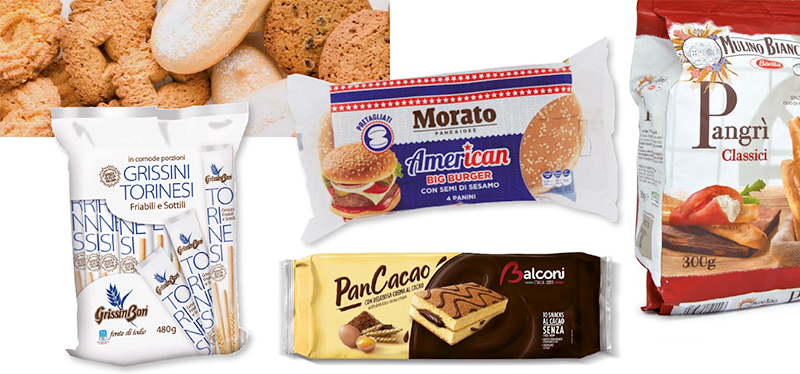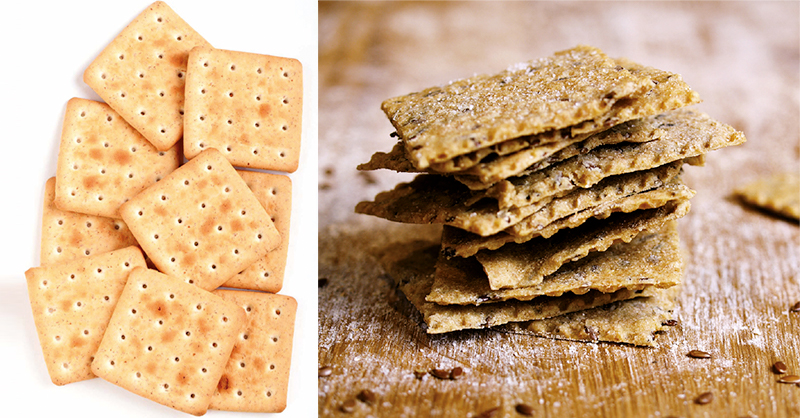Bakery and confectionery products
Trend of the sector in Italy and focus on the types of packaging of industrial products: final data 2019 and evolutionary hypothesis 2020.

In 2019, the “bakery and confectionery products” segment accounted for about 4% of the overall turnover of the food industry,
The product categories that fall under this umbrella are many and their production is intended for both domestic and foreign markets.
The products monitored in this analysis are: bread and its substitutes (crackers, breadsticks, croutons, etc.), cookies and rusks, brioches and snacks, cakes and small packaged confectionery, festive products (panettone, Easter doves, etc.).
In 2019, the sector produced more than 1,270 t/000, recording a growth trend of about 1%.
The most representative category in terms of production is cookies, which accounts for 47.4% and alone grew 2% in 2019.
This is followed by packaged confectionery (18% of the sector, the only one, however, to register a 1% decline). On the other hand, the areas of snacks and bread substitutes are growing, both at +2%.
The industrial bread area grew by 0.3%, a fact to be highlighted if we consider that the bread sector, including bulk sales, has been registering negative trends for several years now.
Exports in 2019 fully supported national production, of which they absorb about 50%, settling around 631 t/000, with a growth rate of 12% compared to 2018.
Imports, which are around 327 t/000 turn out to have grown by 3.8%.
With regard to foreign trade, it should be noted that it refers mainly to the cookie sector.
Ipotesi 2020
As far as 2020 is concerned, the sector shows a positive trend (similarly to other food products), with production growing by 1.4%. This is a respectable result, if one considers the general trend of the industry and the world economy. On the other hand, as is well known, the food industry was one of the few areas that remained active even during the lock-down months, bringing undeniable benefits to the sector under examination, although the performance of bakery products is not up to the level of other types of food, such as pasta or beverages.
In addition to domestic consumption, the production of bakery and confectionery products in 2020 was also supported by exports, which are expected to grow by 2% compared to 2019; on the other hand, imports are down by about 9%. From the first elaborations on the 2020 consumption data (Source Nielsen), it appears that cookies have largely driven the sector, standing at about 51% of the entire production of bakery products; the year is expected to close with a growth trend of +3%.
In fact, other product categories are also expected to grow, with the exception of packaged cakes, which are expected to record a 9% drop in consumption.

Packaging trends
In the choice of packaging for the “bakery and confectionery products” sector, the ability to maintain product freshness, preserving its qualitative characteristics (softness in some cases and crunchiness in others), remains fundamental.
In recent years, the sector has expressed at various levels - and like other industrial areas - additional needs, linked to sustainability policies (request for packaging solutions with a lower environmental impact, perhaps recyclable), the fight against food waste (smaller formats), the search for materials capable of making packages more attractive and recognizable... All the product categories in the area, in the packaging mix, still see a clear prevalence of laminated packaging.
Considering the sector as a whole, 98.1% of packaging is made up of laminated flexible packaging, whether plastic or paper-based, followed by 1.1% of plastic bags.
The remaining 0.8% is divided between cardboard boxes (0.7%) and a very small quantity of decorated steel tins (0.1%).
But if laminated packaging remains the most widespread type of packaging, the materials used vary.
For example, as far as cookies are concerned, 96% of packaging is represented by flexible laminated bags, mainly paper, 2.3% is represented by plastic bags and 1.5% by cardboard boxes. Fancy steel tins represent the remaining 0.2%.
With reference to the remaining product categories, packaging is represented exclusively by plastic converter pouches in flexible laminate.
Then there are some exceptions, due to distribution characteristics. This is the case of snacks or crackers: in both cases, the single-portion product is packaged in a plastic bag made of 20 - 30 micron PP monofilm. The individual single portions are then packaged as a multipack in a cardboard box, which is then enclosed in a flexible converter laminate pouch.
In 2019, the entire industry used a total amount of packaging of about 185,000 t for production, including primary, secondary and transport packaging (of this, about half refers to exported products)
The packaging mix data refer to the year 2019, but this breakdown has been stable over the years, making the various positions of the different types of packaging constant over time.
The challenge in future years will still be that of providing increasingly sustainable and easily recyclable packaging.
Barbara Iascone, Istituto Italiano Imballaggio




















